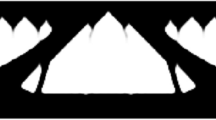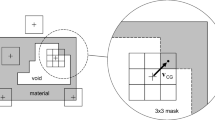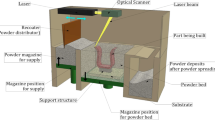Abstract
This paper studies additive manufacturing (AM) oriented structural topology optimization (TO). The minimum compliance design subject to overhang angle constraint with overhang length relaxation and horizontal minimum length control is considered. Although the overhang length relaxation allows additional flexibility for AM product design, there have been very limited studies on it. This paper elucidates that the overhang angle constraint we proposed can identify the lower boundary element that violates the overhang angle constraint. Taking advantage of this fact, we achieve the overhang length relaxation by specifying that the volume fraction of the elements that violate the overhang angle constraint in each local area of the design domain is less than a specified upper bound. A formula for estimating the maximum allowable overhang length of this method is proposed and verified. The horizontal minimum length constraint is also employed in this paper. While controlling the horizontal length size of the structural member, this constraint together with the overhang angle constraint with overhang length relaxation suppresses the hanging feature. The gradient-based optimization algorithm method of moving asymptotic (MMA) is used to solve the TO formulation. Numerical examples show the effectiveness of this method. It is observed that the new constraint alleviates the main issues of traditional overhang angle constraints, i.e., gray element issue, stress concentration issue, and shattered structure issue. Compared with the strict traditional overhang angle constraint, the new formulation reduces structural compliance.
Similar content being viewed by others
References
Bendsøe M P, Kikuchi N. Generating optimal topologies in structural design using a homogenization method. Comput Methods Appl Mech Eng, 1988, 71: 197–224
Zhang K, Cheng G, Xu L. Topology optimization considering overhang constraint in additive manufacturing. Comput Struct, 2019, 212: 86–100
Zhang K Q, Cheng G D. Three-dimensional high resolution topology optimization considering additive manufacturing constraints. Addit Manuf, 2020, 35: 101224
Langelaar M. An additive manufacturing filter for topology optimization of print-ready designs. Struct Multidisc Optim, 2017, 55: 871–883
Allaire G, Dapogny C, Estevez R, et al. Structural optimization under overhang constraints imposed by additive manufacturing technologies. J Comput Phys, 2007, 351: 295–328
Zhang W, Zhou L. Topology optimization of self-supporting structures with polygon features for additive manufacturing. Comput Methods Appl Mech Eng, 2018, 334: 56–78
Wang Y, Gao J, Kang Z. Level set-based topology optimization with overhang constraint: Towards support-free additive manufacturing. Comput Methods Appl Mech Eng, 2018, 339: 591–614
Gaynor A T, Guest J K. Topology optimization for additive manufacturing: considering maximum overhang constraint. In: Proceedings of the 15th AIAA/ISSMO Multidisciplinary Analysis and Optimization Conference. Atlanta, 2014. 16–20
Gaynor A T, Guest J K. Topology optimization considering overhang constraints: Eliminating sacrificial support material in additive manufacturing through design. Struct Multidisc Optim, 2016, 54: 1157–1172
Qian X. Undercut and overhang angle control in topology optimization: A density gradient based integral approach. Int J Numer Meth Engng, 2017, 111: 247–272
Guo X, Zhou J, Zhang W, et al. Self-supporting structure design in additive manufacturing through explicit topology optimization. Comput Methods Appl Mech Eng, 2017, 323: 27–63
Johnson T E, Gaynor A T. Three-dimensional projection-based topology optimization for prescribed-angle self-supporting additively manufactured structures. Addit Manuf, 2018, 24: 667–686
Langelaar M. Topology optimization of 3D self-supporting structures for additive manufacturing. Addit Manuf, 2016, 12: 60–70
Langelaar M. Topology optimization for additive manufacturing with controllable support structure costs. In: Proceedings of the 7th European Congress on Computational Methods in Applied Sciences and Engineering. National Technical University of Athens (NTUA), 2016
Guest J K, Prévost J H, Belytschko T. Achieving minimum length scale in topology optimization using nodal design variables and projection functions. Int J Numer Meth Eng, 2004, 61: 238–254
Zhang W, Zhong W, Guo X. An explicit length scale control approach in SIMP-based topology optimization. Comput Methods Appl Mech Eng, 2014, 282: 71–86
Lazarov B S, Wang F, Sigmund O. Length scale and manufacturability in density-based topology optimization. Arch Appl Mech, 2016, 86: 189–218
Guo X, Zhang W, Zhang L. Robust structural topology optimization considering boundary uncertainties. Comput Methods Appl Mech Eng, 2013, 253: 356–368
Kang Z, Luo Y. Non-probabilistic reliability-based topology optimization of geometrically nonlinear structures using convex models. Comput Methods Appl Mech Eng, 2009, 198: 3228–3238
Qian X, Sigmund O. Topological design of electromechanical actuators with robustness toward over- and under-etching. Comput Methods Appl Mech Eng, 2013, 253: 237–251
Schevenels M, Lazarov B S, Sigmund O. Robust topology optimization accounting for spatially varying manufacturing errors. Comput Methods Appl Mech Eng, 2011, 200: 3613–3627
Li Q, Chen W, Liu S, et al. Structural topology optimization considering connectivity constraint. Struct Multidisc Optim, 2016, 54: 971–984
Liu C, Zhu Y, Sun Z, et al. An efficient moving morphable component (MMC)-based approach for multi-resolution topology optimization. Struct Multidisc Optim, 2018, 58: 2455–2479
Nguyen T H, Paulino G H, Song J, et al. A computational paradigm for multiresolution topology optimization (MTOP). Struct Multidisc Optim, 2010, 41: 525–539
Poulsen T A. Topology optimization in wavelet space. Int J Numer Meth Eng, 2002, 53: 567–582
Guest J K, Smith Genut L C. Reducing dimensionality in topology optimization using adaptive design variable fields. Int J Numer Meth Eng, 2010, 81: 1019–1045
Groen J P, Sigmund O. Homogenization-based topology optimization for high-resolution manufacturable microstructures. Int J Numer Meth Eng, 2018, 113: 1148–1163
Wang D, Yang Y, Yi Z, et al. Research on the fabricating quality optimization of the overhanging surface in SLM process. Int J Adv Manuf Technol, 2013, 65: 1471–1484
Kranz J, Herzog D, Emmelmann C. Design guidelines for laser additive manufacturing of lightweight structures in TiAl6V4. J Laser Appl, 2015, 27: S14001–1
Mertens R, Clijsters S, Kempen K, et al. Optimization of scan strategies in selective laser melting of aluminum parts with downfacing areas. J Manuf Sci Eng, 2014, 136: 61012
Bendsøe M P. Optimal shape design as a material distribution problem. Struct Optim, 1989, 1: 193–202
Zhou M, Rozvany G I N. The COC algorithm, part II: topological, geometrical and generalized shape optimization. Comput Methods Appl Mech Eng, 1991, 89: 309–336
Zhou M, Liu Y, Wei C. Topology optimization of easy-removal support structures for additive manufacturing. Struct Multidisc Optim, 2020, 61: 2423–2435
Fu Y F, Rolfe B, Chiu L N S, et al. Design and experimental validation of self-supporting topologies for additive manufacturing. Virtual Phys Prototyp, 2019, 14: 382–394
Ven E, Ayas C, Langelaar M, et al. A PDE-based approach to constrain the minimum overhang angle in topology optimization for additive manufacturing. In: Advances in Structural and Multidisciplinary Optimization. WCSMO 2017. Cham: Springer, 2017
Luo Y F, Sigmund O, Li Q H, et al. Additive manufacturing oriented topology optimization of structures with self-supported enclosed voids. Comput Methods Appl Mech Eng, 2020, 372: 113385
Deng H, To A C. Linear and nonlinear topology optimization design with projection-based ground structure method (P-GSM). Int J Numer Methods Eng, 2020, 366: 113093
Zhou L, Sigmund O, Zhang W H. Self-supporting structure design with feature-driven optimization approach for additive manufacturing. Comput Methods Appl Mech Eng, 2011, 396: 114110
Fu Y F. Recent advances and future trends in exploring Pareto-optimal topologies and additive manufacturing oriented topology optimization. Math Biosci Eng, 2020, 17: 4631–4656
Garaigordobil A, Ansola R, Fernandez de Bustos I. On preventing the dripping effect of overhang constraints in topology optimization for additive manufacturing. Struct Multidisc Optim, 2021, 64: 4065–4078
Liu J K, Yu H. Self-support topology optimization with horizontal overhangs for additive manufacturing. J Manuf Sci Eng-Trans ASME, 2009, 142: 1–19
Pellens J, Lombaert G, Lazarov B, et al. Combined length scale and overhang angle control in minimum compliance topology optimization for additive manufacturing. Struct Multidisc Optim, 2019, 59: 2005–2022
Guest J K. Imposing maximum length scale in topology optimization. Struct Multidisc Optim, 2009, 37: 463–473
Wu J, Clausen A, Sigmund O. Minimum compliance topology optimization of shell-infill composites for additive manufacturing. Comput Methods Appl Mech Eng, 2017, 326: 358–375
Clausen A, Aage N, Sigmund O. Topology optimization of coated structures and material interface problems. Comput Methods Appl Mech Eng, 2015, 290: 524–541
Clausen A, Andreassen E, Sigmund O. Topology optimization of 3D shell structures with porous infill. Acta Mech Sin, 2017, 33: 778–791
Xu S, Cai Y, Cheng G. Volume preserving nonlinear density filter based on Heaviside functions. Struct Multidisc Optim, 2010, 41: 495–505
Bruns T E, Tortorelli D A. Topology optimization of non-linear elastic structures and compliant mechanisms. Comput Methods Appl Mech Eng, 2001, 190: 3443–3459
Bourdin B. Filters in topology optimization. J Manuf Sci Eng-Trans ASME, 2001, 50: 2143–2158
Svanberg K. The method of moving asymptotes—a new method for structural optimization. Int J Numer Meth Engng, 1987, 24: 359–373
Wang F, Lazarov B S, Sigmund O. On projection methods, convergence and robust formulations in topology optimization. Struct Multidisc Optim, 2011, 43: 767–784
Sigmund O. Manufacturing tolerant topology optimization. Acta Mech Sin, 2009, 25: 227–239
Author information
Authors and Affiliations
Corresponding author
Additional information
This work was supported by the National Natural Science Foundation of China (Grant Nos. 52075070 and 12032008).
Supporting Information
The supporting information is available online at tech.scichina.com and link.springer.com. The supporting materials are published as submitted, without typesetting or editing. The responsibility for scientific accuracy and content remains entirely with the authors.
Electronic Supplementary Material
Rights and permissions
About this article
Cite this article
Zhang, K., Cheng, G. & Wang, Y. Structural topology optimization subject to overhang angle constraint with overhang length relaxation in additive manufacturing. Sci. China Technol. Sci. 65, 1213–1231 (2022). https://doi.org/10.1007/s11431-021-1996-y
Received:
Accepted:
Published:
Issue Date:
DOI: https://doi.org/10.1007/s11431-021-1996-y




